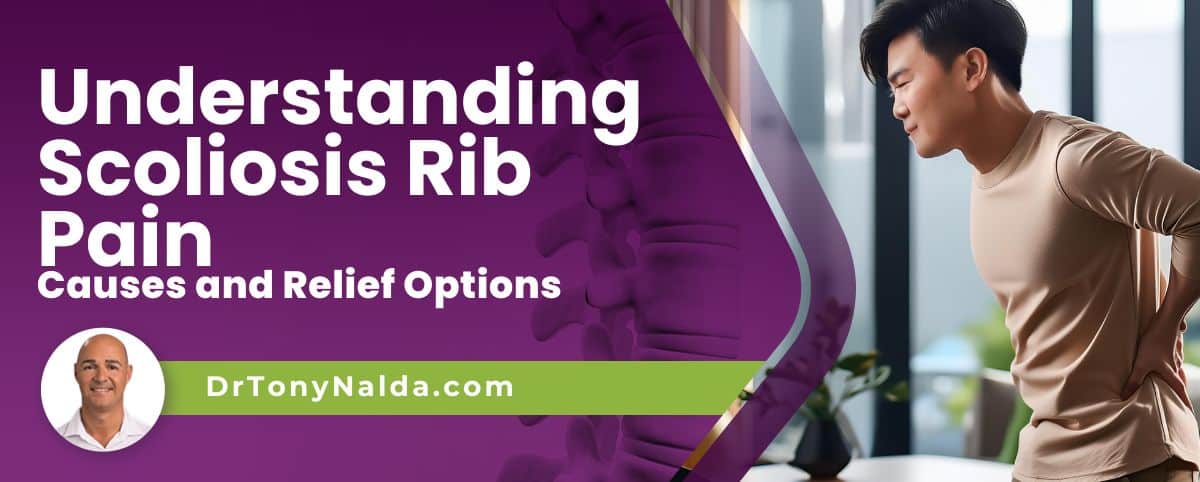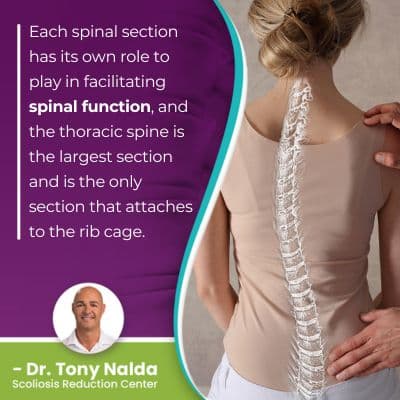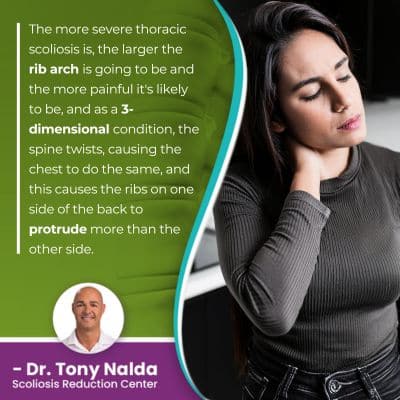Understanding Scoliosis Rib Pain: Causes and Relief Options

Although scoliosis is a structural spinal condition that causes the spine to develop an unnatural spinal curve, its effects can be widespread and not isolated to the spine. Scoliosis pain can involve back pain, nerve tension and pain that radiates into the extremities due to compression, muscle pain, and/or rib pain.
Scoliosis rib pain is caused by the development of a rib cage arch that can develop as an unnatural spinal curve is pulling on the rib cage and causing one side to protrude more than the other. Scoliosis rib pain is most closely associated with thoracic scoliosis.
As a patient's scoliosis journey starts with a diagnosis, let's start with the parameters that have to be met to reach a diagnosis of scoliosis.
Table of Contents
Diagnosing Scoliosis
Diagnosing scoliosis isn't always easy; there are different severity levels, types, and the condition's early signs can be subtle and difficult for anyone other than a specialist to detect.
While there are no treatment guarantees, with early detection and intervention, there are fewer limits to what can be achieved with nonsurgical treatment, and treating scoliosis without surgery is the best way to preserve as much of the spine's natural strength and function as possible.
Diagnosing scoliosis means an unnatural sideways spinal curve has developed, and with scoliosis, there is also a rotational component, meaning the spine also twists, making it a complex 3-dimensional condition.
Scoliotic curves also have to be of a minimum size: Cobb angle measurement of at least 10 degrees.
Cobb angles are measured by drawing lines from the tops and bottoms of the curve's most-tilted vertebrae, and the resulting angle is expressed in degrees.
A physical examination that includes taking the patient's family history and medical history, examining the spine when in a forward bend position, and an X-ray is needed to diagnose scoliosis.
A scoliosis X-ray is needed to confirm a rotational component and determine the patient's Cobb angle.
Symptoms such as rib pain will depend on a number of factors such as condition type, severity, patient age, and curvature location, and conditions are classified based on these variables that then shape the customization of treatment plans.
Does All Scoliosis Cause Rib Pain?
There are three main spinal sections, and scoliosis can develop in any one section, or in more than one as a combined scoliosis.
The cervical spine refers to the neck, thoracic spine to the middle and upper back, and the lumbar spine includes the lower back.
 Each spinal section has its own role to play in facilitating spinal function, and the thoracic spine is the largest section and is the only section that attaches to the rib cage.
Each spinal section has its own role to play in facilitating spinal function, and the thoracic spine is the largest section and is the only section that attaches to the rib cage.
The thoracic spine supports the abdomen and chest, and as it attaches to the rib cage, provides support for the rib cage, while the rib cage provides structural support for the thoracic spine, so the thoracic spine and the rib cage also work together to protect important organs like the heart and lungs.
So not all scoliosis will cause rib pain; in most cases, the area of the body located the closest to the affected spinal section is going to be the most likely to feel the condition's direct effects, so the effects of cervical scoliosis are more likely to be felt in the shoulders, neck, and head, and the effects of lumbar scoliosis are most likely to affect the pelvis, hips, and lower body in general.
Thoracic Scoliosis and Rib Pain
The thoracic spine attaches to the rib cage, and if the spinal section has developed an unnaturally bent and twisted spinal curvature, that spinal curve is pulling on the rib cage and can disrupt its position.
Condition severity is also a key factor when it comes to experienced symptoms; the more severe a condition is, the more noticeable symptoms are going to be, including postural changes and pain.
As scoliosis progresses, the condition's uneven forces disrupt the body's overall symmetry, and related postural changes become more overt, such as the development of a rib cage arch.
 The more severe thoracic scoliosis is, the larger the rib arch is going to be and the more painful it's likely to be, and as a 3-dimensional condition, the spine twists, causing the chest to do the same, and this causes the ribs on one side of the back to protrude more than the other side.
The more severe thoracic scoliosis is, the larger the rib arch is going to be and the more painful it's likely to be, and as a 3-dimensional condition, the spine twists, causing the chest to do the same, and this causes the ribs on one side of the back to protrude more than the other side.
Asymmetries in the trunk and rib cage are most noticeable when in a forward bend position.
In addition, when it comes to scoliosis pain, patient age is a key factor; scoliosis doesn't become a compressive condition until skeletal maturity has been reached.
Once growth has stopped, compression of the spine (uneven pressure) and its surrounding nerves and muscles is the main cause of condition-related pain.
Scoliosis can range from mild scoliosis to moderate scoliosis, severe and very severe scoliosis, so for adults patients, and patients with severe thoracic scoliosis, rib and chest pain is more likely to be a factor.
Rib arches can be noticeable and painful, and the best way to prevent rib hump pain and chest pain from becoming an issue is to treat the underlying cause of the rib pain proactively: the condition itself.
Scoliosis Rib Pain Treatment
There are two main scoliosis treatment approaches for patients to choose between, surgical and nonsurgical, and choosing one type of treatment over another can shape the spine's long-term health and function so is an important decision.
As a structural spinal condition, scoliosis needs to be impacted on a structural level primarily, and in conservative nonsurgical treatment, this is worked towards through condition-specific chiropractic care.
A series of chiropractic techniques and adjustments can reposition the curve's most-tilted vertebrae back into alignment with the rest of the spine, addressing the structural abnormality within the spine itself.
Another key facet of treatment involves physical therapy and scoliosis-specific exercises that can work towards increasing the spine's flexibility and strength of the spine's surrounding muscles; the spine's surrounding muscles provide the spine with support and stability.
Physical therapy and exercise can also address any muscle imbalance and related muscle pain that develops as the unnatural spinal pulls the spine's surrounding muscles in different directions, causing the muscles on one side to become stretched and sore from overuse and the muscles on the other side to become weak from overuse.
For young patients whose spines are still growing, corrective bracing can help correct the scoliosis by pushing the spine into a straighter position and alignment, and adolescent idiopathic scoliosis, diagnosed between the ages of 10 and 18 is the most prevalent form.
Rehabilitation can involve continued chiropractic care and/or the prescription of a series of scoliosis-specific exercises that can be performed from home to further heal and stabilize the spine.
Surgical treatment can realign the spine, but it's an invasive, costly, and risky procedure that can cost the spine in other ways, and trunk rotation and postural changes aren't a focus of spinal fusion, so patients are often disappointed with the cosmetic results of scoliosis surgery.
Conclusion
Scoliosis rib pain is caused by postural deviation and the uneven forces of scoliosis.
Thoracic scoliosis is most closely associated with rib and chest pain because as the only spinal section attached to the rib cage, a sideways curve of the spine will disrupt the position of the rib cage within the chest wall and cause one side to protrude more than the other, known as a rib hump or arch.
Scoliosis rib pain and pain in general isn't always a noticeable symptom, particularly in young patients whose spines are still growing; they are experiencing a constant lengthening motion that counteracts the compressive force of the unnatural sideways spinal curve.
In particularly severe thoracic scoliosis cases and/or if left untreated, related complications such as lung impairment and a detectable shortness of breath can develop; however, this isn't considered a common symptom, and breathing difficulties, if present, are generally only noticeable to patients who place higher-than-average demands on their respiratory systems.
A curvature reduction is addressing the condition's structural nature so related symptoms such as postural deviation will improve as their underlying cause, the condition itself, is being corrected.
When it comes to progressive conditions like scoliosis, the best time to start treatment is always now; mild curves are simpler to treat than moderate and severe scoliosis, hence the benefit of proactive treatment that works towards preventing progression, increasing effects, and the need for invasive surgical treatment in the future.
Here at the Scoliosis Reduction Center®, scoliosis rib pain is treated proactively by starting treatment as close to the time of diagnosis as possible; this is the best means of preventing progression and managing symptoms.
Dr. Tony Nalda
DOCTOR OF CHIROPRACTIC
After receiving an undergraduate degree in psychology and his Doctorate of Chiropractic from Life University, Dr. Nalda settled in Celebration, Florida and proceeded to build one of Central Florida’s most successful chiropractic clinics.
His experience with patients suffering from scoliosis, and the confusion and frustration they faced, led him to seek a specialty in scoliosis care. In 2006 he completed his Intensive Care Certification from CLEAR Institute, a leading scoliosis educational and certification center.
About Dr. Tony Nalda
 Ready to explore scoliosis treatment? Contact Us Now
Ready to explore scoliosis treatment? Contact Us Now





